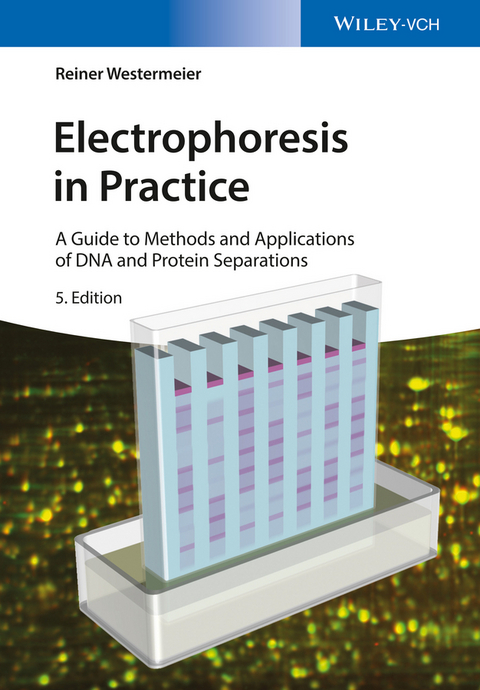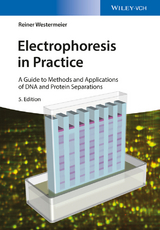Electrophoresis in Practice
Wiley-VCH (Verlag)
978-3-527-33880-1 (ISBN)
- Titel ist leider vergriffen;
keine Neuauflage - Artikel merken
Reiner Westermeier worked after PhD graduation and Post-doc at the Technische Universität München for 30 years as a specialist for electrophoresis methods for leading bioanalytics and biotechnology companies. His area of responsibility included co-operation in product development, writing of scientic papers and method instructions, trouble shooting in customer laboratories, performing seminars and practical courses on electrophoresis and proteomics, as well as giving scientific talks at congresses on a world-wide basis. He is editor and author of several books, e.g. 'Electrophoresis in Practice' (in German and in English), 'Proteomics in Practice', and 'Difference Gel Electrophoresis'.
Contents
Part I
Fundamentals and History
Introduction
1 Electrophoresis
1.0 General
1.1 Electrophoresis in non-restrictive gels
1.1.1 Agarose gel electrophoresis
1.1.2 Polyacrylamide gel electrophoresis of low-molecular weight substances
1.2 Electrophoresis in restrictive gels
1.2.1 The Ferguson plot
1.2.2 Agarose gel electrophoresis
1.2.3 Polyacrylamide gel electrophoresis of nucleic acids
1.2.4 Polyacrylamide gel electrophoresis of proteins
2 Isotachophoresis
2.1 Migration with the same speed
2.2 "Ion train" separation
2.3 Zone sharpening effect
2.4 Concentration regulation effect
3 Isoelectric focusing
3.1 Principles
3.2 Gels for IEF
3.3 Temperature
3.4 Controlling the pH gradient
3.5 The kinds of pH gradients
3.5.1 Free carrier ampholytes
3.5.2 Immobilized pH gradients
3.6 Protein detection in IEF gels
3.7 Preparative isoelectric focusing
3.8 Titration curve analysis
4 Blotting
4.1 Principle
4.2 Transfer methods
4.3 Blotting membranes
4.4 Buffers for electrophoretic transfers
4.5 General staining
4.6 Blocking
4.7 Specific detection
4.8 Protein sequencing
4.9 Transfer problems
5 Interpretation of electropherograms
5.1 Introduction
5.1.1 Purity control
5.1.2 Quantification prerequisites
5.2 Image analysis
5.2.1 Hardware for image analysis
5.2.2 Software for image analysis
6 Proteome Analysis
6.1 General
6.2 Sample preparation
6.3 Two-dimensional electrophoresis
6.4 Detection techniques
6.5 Image analysis
6.6 Protein spot identification
6.6.1 Mass spectrometry methods
6.6.2 Peptide mass fingerprinting
6.6.3 Protein characterization
6.7 Bioinformatics
6.8 Functional proteomics
7 Instrumentation
7.1 Current and voltage conditions
7.2 Power supply
7.3 Separation chambers
7.3.1 Vertical apparatus
7.3.2 Horizontal apparatus
7.4 Staining apparatus for gels and blots
7.5 Automated electrophoresis
7.6 Instruments for 2-D electrophoresis
7.6.1 Isoelectric focusing apparatus
7.6.2 Multiple slab gel apparatus
7.7 Safety measures
7.8 Environmental aspects
Equipment for Part II
Instrumentation
Laboratory equipment
Consumables
Chemicals
Part II
Methods
Method 1: PAGE of dyes
1 Sample preparation
2 Stock solutions
3 Preparing the casting cassette
4 Casting the ultrathin-layer gels
5 Electrophoretic separation
Method 2: PAGE of DNA Fragments
1 Stock solutions
2 Preparing the gels
3 Sample preparation
4 Electrophoresis
5 Silver staining
Method 3: Agarose and immuno electrophoresis
1 Sample preparation
2 Stock solutions
3 Preparing the gels
4 Electrophoresis
5 Protein detection
Method 4: Titration curve analysis
1 Sample preparation
2 Stock solutions
3 Preparing the blank gels
4 Titration curve analysis
5 Coomassie and silver staining
6 Interpreting the curves
Method 5: Native PAGE in amphoteric buffers
1 Sample preparation
2 Stock solutions
3 Preparing the empty gels
4 Electrophoresis
5 Coomassie and silver staining
Method 6: Agarose IEF
1 Sample preparation
2 Preparing the agarose gel
3 Isoelectric focusing
5 Protein detection
Method 7: PAGIEF in rehydrated gels
1 Sample preparation
2 Stock solutions
3 Preparing the blank gels
4 Isoelectric focusing
5 Coomassie and silver staining
6 Perspectives
Method 8: Horizontal SDS-PAGE
1 Sample preparation
2 Stock solutions for the preparation of gels
3 Preparing the casting cassette
4 Gradient gel
5 Electrophoresis
6 Protein detection
7 Blotting
8 Perspectives
Method 9: Vertical PAGE
1 Sample preparation
2 Stock solutions
3 Single gel casting
4 Multiple gel casting
5 Electrophoresis
6 SDS electrophoresis of small peptides
7 Two-dimensional electrophoresis
8 DNA electrophoresis
9 Long shelflife gels
10 Protein detection
Method 10: Semi-dry blotting of proteins
1 Transfer buffers
2 Technical procedure
3 Staining of blotting membranes
Method 11: IEF in immobilized pH gradients
1 Sample preparation
2 Stock solutions
3 Immobiline recipes
4 Preparing the casting cassette
5 Preparing the pH gradient gels
6 Isoelectric focusing
7 Staining
8 Strategies for IPG focusing
Method 12: High-resolution 2D electrophoresis
1 Sample preparation
2 Stock solutions
3 Preparing the gels
4 Separation conditions
5 Staining procedures
6 DIGE
Appendix
A Trouble-shooting guide
A1 Isoelectric focusing
A1.1 PAGIEF with carrier ampholytes
A1.2 Agarose IEF with carrier ampholytes
A1.3 Immobilized pH gradients
A2 SDS electrophoresis
A3 Vertical PAGE
A4 Semi-dry blotting
A5 2-D electrophoresis
A6 DNA electrophoresis
B References
Index
| Erscheint lt. Verlag | 7.4.2016 |
|---|---|
| Verlagsort | Berlin |
| Sprache | englisch |
| Maße | 170 x 244 mm |
| Gewicht | 1152 g |
| Themenwelt | Naturwissenschaften ► Biologie ► Biochemie |
| Naturwissenschaften ► Biologie ► Genetik / Molekularbiologie | |
| Naturwissenschaften ► Biologie ► Mikrobiologie / Immunologie | |
| Naturwissenschaften ► Chemie ► Analytische Chemie | |
| Schlagworte | Biochemie u. Chemische Biologie • Biochemistry (Chemical Biology) • Biowissenschaften • Cell & Molecular Biology • Chemie • Chemistry • Chromatographie • Chromatographie / Trennverfahren • Chromatography / Separation Techniques • Elektrophorese • Genomforschung u. Proteomik • Genomics & Proteomics • Life Sciences • Proteine • Proteine u. Makromoleküle • Proteins & Macromolecules • Zell- u. Molekularbiologie |
| ISBN-10 | 3-527-33880-2 / 3527338802 |
| ISBN-13 | 978-3-527-33880-1 / 9783527338801 |
| Zustand | Neuware |
| Informationen gemäß Produktsicherheitsverordnung (GPSR) | |
| Haben Sie eine Frage zum Produkt? |
aus dem Bereich




